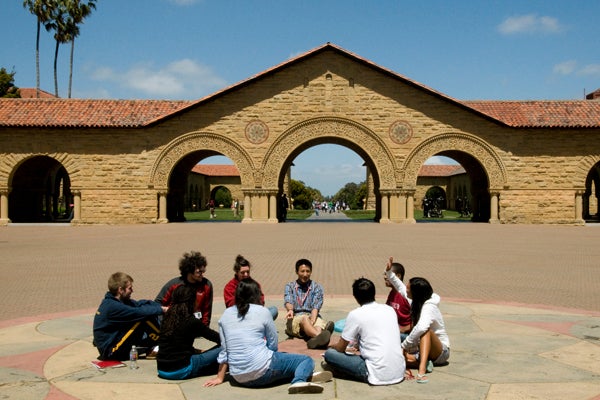|
January 26, 2012
Stanford University proposes reimagining undergraduate education

A key recommendation is that Stanford guarantee that freshmen are exposed to a variety of instructional and learning styles so they experience new ways of learning that are a departure from their days in high school. (Photo: Linda A. Cicero / Stanford News Service) Stanford University today will release The Study of Undergraduate Education at Stanford University, a comprehensive examination of teaching and learning that makes 55 recommendations to prepare students to face the challenges and opportunities of an ever-changing world.
The 128-page report will be presented to the Faculty Senate.
The report by Stanford faculty members proposes structuring the breadth requirements – courses students take outside their majors – with a new "Ways of Thinking, Ways of Doing" approach that focuses not only on the content of a particular course, but also on the essential capacities a Stanford graduate should possess.
The report says students need knowledge, but they also need to develop capacities for continued intellectual growth, and the ability to apply the skills and knowledge they accrued at Stanford to the novel challenges awaiting them in the wider world.
Under the proposed model, Stanford will encourage students to develop seven essential skills: aesthetic and interpretive inquiry; social inquiry; scientific analysis; formal and quantitative reasoning; engaging difference; moral and ethical reasoning; and creative expression.
"The SUES report takes apart the traditional components of a liberal education and reassembles them in a scaffold that can better support the structure of modern knowledge and the needs of today's student," said Provost John Etchemendy.
"The study provides a thoughtful and thorough assessment of the goals of undergraduate education, and applies its findings in creative and compelling ways. I expect it to have a major impact both at Stanford and on other campuses."
A key recommendation is that Stanford guarantee that freshmen are exposed to a variety of instructional and learning styles, including lectures, discussion sessions and intimate seminars, so they experience new ways of learning that are a departure from their days in high school.
James T. Campbell, a Stanford history professor and co-chair of the committee that produced the study, said the report directs attention not only to what professors teach, but also how they teach, as well as how and where Stanford students learn.
"From our perspective, liberal education is not some roster of required courses to round out the major, but the totality of our students’ education," Campbell said. "It encompasses all four years and embraces not only curricula – breadth requirements and courses in the major – but also dorm life, overseas studies, community-based service, and student experiences in laboratories, on athletic fields, in internships and in student groups – all of the places where our students learn and grow."
The study provides a broad and thoughtful assessment about the nature and purposes of undergraduate education in the 21st century.
Its goal was to design an education equal to the unfathomable challenges and opportunities that await students as they make their way in the world as citizens and as leaders, to equip them to succeed and flourish, and to live useful, creative, responsible and reflective lives.
It also answers a question Provost Etchemendy posed to the committee: How can we best prepare students for local, national and global citizenship?
The study said students need breadth and depth of knowledge; a range of essential skills and capacities – starting with the capacity for effective communication; a deep sense of personal and social responsibility; and the ability to adapt those skills and capacities to new and unforeseen challenges.
In particular, the study emphasized the importance of "adaptive learning," the ability to integrate new and old experiences, and to adapt knowledge and skills to novel circumstances. The committee was surprised by how few structured opportunities students have been given to cultivate this essential capacity.
"For all their amazing abilities and energy, we found that many of the students we talked to over the past two years lead highly compartmentalized lives," said Susan McConnell, a Stanford biology professor and co-chair of the committee.
"The different spheres of their experience – in classrooms, in the residences, through service and out in the world – are separated rather than integrated. If there is a single motivating principle that ties together our recommendations, it's our determination to breach these silos. We want to offer students an education that's more than the sum of its parts, an education that enables students to make connections across disciplines and between the different realms of their lives."
Harry Elam, vice provost for undergraduate education at Stanford, said the proposals give faculty a license to explore new ways of teaching.
"With its emphasis on student learning, the report encourages faculty to reimagine the classroom experience," Elam said. "The report incites faculty to experiment with new ways of sharing and creating knowledge."
Among the other major recommendations of the study:
- Bring freshmen immediately into university-level thinking by engaging them in rigorous consideration of large or enduring questions in "Thinking Matters" courses, and by requiring them to take an introductory seminar. Currently, introductory seminars are optional.
- Expand the September Studies Program by piloting additional programs aimed at students in their junior year, as well as programs aimed at developing leadership, civic engagement, or innovation.
- Offer sets of related courses that a cohort of students would take together during a single quarter, each course offered in an intensive, three-week block.
- Expand the Bing Overseas Studies Program by increasing the number and variety of opportunities for students, and reducing the obstacles that prevent some students – such as athletes with jam-packed schedules – from studying abroad.
- Establish a Stanford in the Bay Area program, modeled on the Bing Stanford in Washington Program, to give students another way to integrate community-based learning into their undergraduate experiences.
-30-
|